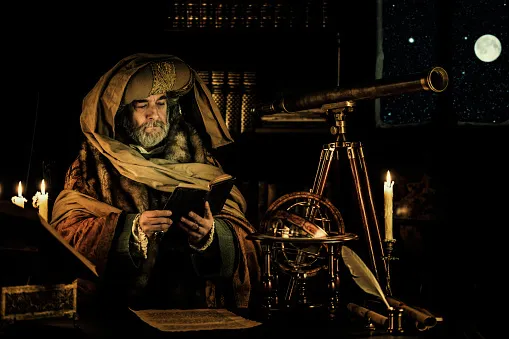
He creatively invertedthe method of calculating heights by using shadows, by using light instead. He mentally rotatedthe picture of the moon he saw through the telescope, to view the moonfrom another [imagined] viewpoint. He realized that hecould apply what he knew, the Pythagorean theorem, to the problemof finding out how tall the mountains were. He made approximations,without worrying too much about how precise and accurate they were [itturns out that the calculation is relatively insenstive – it doesn’t changevery much- to different approxmations. That is, a small “error” ininput makes no practical difference to the output.] He showed that lunarmountains had to be very much like terrrestrial mountains, in terms oftheir heights. Galileo sparked the birth of modern astronomy with his observations of the Moon, phases of Venus, moons around Jupiter, sunspots, and the news that seemingly countless individual stars make up the Milky Way Galaxy.
The half-crouch position that I finally had to settle for became uncomfortable and made the observing much more difficult. A suggestion for the future is to design each person’s mounting so that the eyepiece sits where it is most comfortable for that person in order to eliminate this annoying problem. In order to avoid the possible contamination of one of Jupiter’s moons, the Galileo space probe was purposely crashed into Jupiter at the end of its mission in September 2003. In 1989, Galileo Galilei was memorialized with the launch of a Jupiter-bound space probe bearing his name. During its 14-year voyage, the Galileo space probe (and its detachable mini-probe) visited Venus, Earth, the asteroid Gaspra, observed the impact of Comet Shoemaker-Levy 9 on Jupiter, Jupiter, Europa, Callisto, Io, and Amalthea. Born in 1564, Italian astronomer Galileo Galilei’s observations of our solar system and the Milky Way have revolutionized our understanding of our place in the Universe.
Galileo Galilei, the famed Italian astronomer, made groundbreaking discoveries in the field of astronomy during the 17th century. One of his notable achievements was calculating the height of the mountains on the moon. But how did he manage to accomplish this feat?
The Telescope Revolution
Galileo’s calculation of the moon’s mountains’ height was made possible by his invention of the telescope. By using a telescope to observe the moon, Galileo was able to see details on its surface that were previously invisible to the naked eye.
Thus, an historical episode can be conceived as an abstract scheme or model in which the historical data are collocated and interconnected. The starting point of my historical narrative was Galileo’s emphasis on the perception problem which clearly emerged only after the publication of ‘The Sidereal Messenger’ in 1610. Thus, the historical episode illustrates a ‘style of scientific work’, a ‘mode of argumentation’ or a form of scientific explanation.
So if, as a jest, and in memory of our friendship then begun, I hail him as joint father of these four stars, again I shall not be doing wrong. One final problem that future groups will find easily correctable is the height of the eyepiece of our telescope. Once I got the telescope angled at the moon, I discovered that the eyepiece was too high for my eye to reach while I was sitting, yet too low to see into while kneeling.
Galileo was not only challenging the science of Aristotle, but the people in power who believed in it. Not knowing that looking at our very own star would damage his eyesight, Galileo pointed his telescope towards the Sun. He discovered that the sun has sunspots, which appear to be dark in color. Galileo turned his gaze toward Venus, the brightest celestial object in the sky – other than the Sun and the Moon. With his observations of the phases of Venus, Galileo was able to figure out that the planet orbits the Sun, not the Earth as was the common belief in his time.
Underneath the icy crust and possible water layer, Europa has a rocky mantle and an iron/iron sulfide core. Keeping the image withing the field of view also became a problem. In spite of our efforts to make the mounting as stable as possible, we could not entirely eliminate the wobble from the telescope. Any slight wind or shakiness of the viewer’s hand, coupled with the tiny field of view, would move the telescope enough for the object under study to move out of the field.
Observation and Measurement
Using his telescope, Galileo carefully observed the moon’s surface and noted the shadows cast by the mountains at different times of day. By measuring the length of these shadows and making calculations based on the angle of the sun’s rays, Galileo was able to estimate the height of the mountains.
Mathematical Formulas
Galileo applied mathematical formulas to his observations in order to calculate the height of the moon’s mountains. By using trigonometry and geometry, he was able to determine the approximate height of these lunar features.
Frequently Asked Questions
- How accurate were Galileo’s calculations?
- Why was Galileo’s discovery important?
While Galileo’s calculations were groundbreaking for his time, they were not as precise as modern measurements. However, his work laid the foundation for future astronomers to further study the moon’s topography.
Galileo’s calculation of the moon’s mountains’ height challenged the prevailing belief that celestial bodies were perfect and unchanging. His work helped to revolutionize our understanding of the universe.




